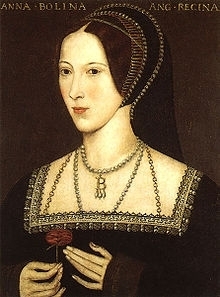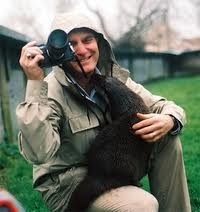Barbara Kyle's Blog: The Rest of the Story - Posts Tagged "henry-viii"
Anne Boleyn and the Colonel: A Tale of Hever Castle

I welcome every message from readers, but there's one I particularly cherish. It concerns an acorn, a castle, and a gallant Colonel.
Here’s the story.
Several years ago I was in England researching The Queen’s Lady, the first book in my Thornleigh Saga series, and I spent a day exploring Hever Castle in Kent. This was the home of the Boleyn family, and Henry VIII came here to court Anne. That tempestuous affair, as we know, changed the course of England’s history—and is pivotal to my book’s plot.
As I strolled the grounds in a happy haze of imagination, I picked up an acorn. I squirreled it away in my pocket and brought it home to Canada, and it sat on my desk beside my computer, a potent reminder of its birthplace as I wrote The Queen’s Lady.
The acorn was still on my desk when I wrote my next Thornleigh Saga book, The King's Daughter. It had become a touchstone that spirited me back to the Tudor world. I was very fond of it.
Then my husband and I moved, and in the shuffle the little acorn got lost.
A few months later I got a cheery email from a reader telling me he was on his way to England for an “Anne Boleyn Tour” during which he’d be staying at Hever Castle. There would be dinners in the great hall where Henry and Anne ate, plus lectures, plays, and demonstrations – “A once in a lifetime experience,” he said. I replied to wish him a happy trip and told him about my acorn. He's a retired US Air Force colonel. His name is Elmer K. Follis and he lives in Tennessee.

Some time later a small package arrived in my mailbox. It was from Colonel Follis. Inside was a note: “I looked for an acorn to replace the one you lost but couldn’t find one. I did get you this.” Nestled under the note was a pine cone. He had scoured the Hever grounds for it. “It’s from the area where Henry courted Anne, according to the castle staff,” wrote the Colonel.
I was so touched. Since then, the pine cone has had pride of place on my desk beside my computer as I've written four more Thornleigh Saga books.
Thank you, Colonel Follis, for what you gave me: a once in a lifetime experience.

*
Visit my website: http://www.barbarakyle.com/
*****
Published on February 20, 2014 07:33
•
Tags:
anne-boleyn, henry-viii, thornleigh-saga
Henry VIII, My Husband, and the Pissing Drunkard
 Writing my first historical novel years ago, I discovered an eye-opening research resource: my husband.
Writing my first historical novel years ago, I discovered an eye-opening research resource: my husband. The Queen's Lady is set during the reign of Henry VIII. Now, Henry and my husband share no similarity regarding tyrannical rule and beheaded wives; I married a thoughtful, peaceable man. He is, however, endowed with the standard issue male anatomy, and this helped my research. Here's how.
In a 1st draft I'd written a scene of a Midsummer Eve celebration in which boisterous revelers dance around bonfires, lovers steal kisses, and a drunk old man pisses as he staggers through the crowd.
Wait a minute, I thought. Can a man do that— urinate while walking?
I took the problem to my husband. "Can a man do that?" I asked.
"I'll go try it," he said, and walked out the door.
Thankfully, we lived on sixty acres of nothing at the end of a dead end road. Not a soul around.
Five minutes later he came back in. "Yup," he reported.
You can see why I value this resource.
At other times I've been grateful to have my husband set me straight on how men think.
For example, in The Queen's Lady I'd written a scene of high drama in which my heroine, Honor Larke, to save her friends' lives, takes a terrifying risk by hiding in the hold of a ship and ends up trapped there as her enemies roam the ship's top deck. If she is found it will mean her death.

I couldn't leave Honor there. Since the ship belonged to her business partner, Richard Thornleigh, who loves her, I wrote a scene of Richard coming on board and bargaining with her enemies.
"I wouldn't do that," said my husband with a frown when he read the scene. "If the woman I loved was trapped in the hold and facing death I'd burn the ship to the waterline and get her out."
I was agog. Of course Richard would do that!
Final draft: Richard swims to the hull at night, climbs aboard unnoticed, sets fire to the mainmast and yells, "Fire!" In the chaos of shouting men he slips down to the hold, frees Honor, throws her through a gun port into the bay, and dives in after her. Saved!

The Queen's Lady was my first novel in the Thornleigh Saga and Kensington Books published it in 2008. Five more have followed. The sixth, The Queen's Exiles, will be released in June 2014. In creating each story I've had my husband read the first draft, chapter by chapter, and he has often made suggestions of sheer magic:
- a trail of gunpowder laid inside hollowed reeds
- a rational way for the heroine to avoid a killer
- the need for my soldier-of-fortune hero to experience an epiphany, to crave a purpose for his life
- the real advice of a man to his friend who's treated his wife badly: "You're an idiot."
Did I use these suggestions? You bet. And many more.

I'm lucky. My husband is no rookie at storytelling. He's been doing it for years as a film producer/director/screenwriter and as a communications expert for progressive organizations advancing environmental and animal welfare issues. (That's him above, with an otter friend.)
After writing six historical novels (and three thrillers before that) I've learned this empowering lesson: it takes a team. I'm blessed with an "A" team. My husband, Stephen Best. My agent, Al Zuckerman of Writers House. My editor at Kensington Books, Esi Sogah.
So when you read my novels' acknowledgements pages in which I thank these people, you know my gratitude is heartfelt.
More on Al and Esi—the rest of the team— in my next posts.
*****
For info about the Thornleigh Saga books, please visit my website: http://www.barbarakyle.com/
*****
Published on March 22, 2014 12:33
•
Tags:
henry-viii, the-queen-s-exiles, the-queen-s-lady, thornleigh, tudor, tudors
Shakespeare, Bloody Mary, and the Bones of Henry VIII
 Research is the lifeblood of our art. Ask any historical novelist and they'll tell you that poring over the letters of our subjects and reading biographies of them and books about their times is a hugely engrossing part of our work. So engrossing, in fact, that I don't think of it anymore as research but The Search.
Research is the lifeblood of our art. Ask any historical novelist and they'll tell you that poring over the letters of our subjects and reading biographies of them and books about their times is a hugely engrossing part of our work. So engrossing, in fact, that I don't think of it anymore as research but The Search.It's like panning for gold. I sit by the riverside day after day sifting through mounds of information sand - solid facts that I need to ground my stories in the truth of the period, but not exactly eye-opening. It's the nuggets I look for. The details that gleam. Facets that will spark my subject to flesh-and-blood life.
Here are a few such nuggets that I alchemized into the life of my books.
 The Queen's Lady features Honor Larke, the (fictional) ward of (the real) Sir Thomas More. More was Henry VIII's chancellor who famously went to the execution block rather than swear the oath that Henry was supreme head of the church in England, a title Henry created so he could divorce Catherine of Aragon and marry Anne Boleyn.
The Queen's Lady features Honor Larke, the (fictional) ward of (the real) Sir Thomas More. More was Henry VIII's chancellor who famously went to the execution block rather than swear the oath that Henry was supreme head of the church in England, a title Henry created so he could divorce Catherine of Aragon and marry Anne Boleyn. My research revealed that in 1517 More was under-sheriff of London, and that on May 1st of that year - "May Day" - the London apprentices rioted and More went with a troop of guards to meet with them. The young men, their torches flaring in the night, were a furious mob, denouncing foreigners for taking their jobs (sound familiar?). They'd gone on a rampage, breaking into foreign-owned shops and assaulting Italians and Flemings in the streets.
The Nugget. Gleaming at me in my research was the fact that, years after More's death, Shakespeare had a hand, along with a couple of other authors, in writing a play called "Sir Thomas More" and in it is a scene of the May Day riot in which More, as undersheriff, addresses the furious apprentices. I went to the British Museum and read the folio. It gave me goose bumps. Shakespeare's brilliance in writing characters glitters in every line he wrote.
More shames the angry young men by asking how would they feel if they were friendless in a faraway county where they would be the foreigners. Would they not hope to be treated with compassion?
For other ruffians, as their fancies wrought,
With self same hand, self reasons, and self right,
Would shark on you, and men like ravenous fishes
Would feed on one another.
He points out an apprentice whose kind Italian master, a foreigner, is giving him a good livelihood and a secure future. With this tolerant rationale More calms the mob. The event is so stirring I used it, reworked to incorporate my created characters, as the opening of The Queen's Lady.
Nugget #2. Sir Thomas More had two young wards, and my research revealed the eye-opening situation of the Tudor Court of Wards. All orphans, male and female, with significant property became wards of the monarch who then sold the wardships to gentlemen who bid for these prizes. Why? Because the guardian got to pocket the rents and revenues of the ward's lands until the ward came of age, at which time the guardian often married the ward to one of his own children, keeping the wealth in the family. I couldn't resist. I created another ward for Sir Thomas More, Honor Larke, to be my novel's heroine. (Read about how the Tudors exploited wardships: https://www.goodreads.com/author_blog....)
 The King's Daughter, features Isabel Thornleigh who joins the uprising led by Sir Thomas Wyatt, a true event in which the rebels sought to unseat Mary I from the throne in the winter of 1554. The only surviving child of Henry VIII and his pious first wife, Catherine of Aragon, Mary was ruled by religious zeal. As queen she oversaw the burning of hundreds of men and women, earning the name her subjects gave her in her lifetime: “Bloody Mary.”
The King's Daughter, features Isabel Thornleigh who joins the uprising led by Sir Thomas Wyatt, a true event in which the rebels sought to unseat Mary I from the throne in the winter of 1554. The only surviving child of Henry VIII and his pious first wife, Catherine of Aragon, Mary was ruled by religious zeal. As queen she oversaw the burning of hundreds of men and women, earning the name her subjects gave her in her lifetime: “Bloody Mary.” Mary was very close to her mother, Catherine, and badly treated by her father. He treated Catherine even worse, sending her off to a damp, drafty house in the fens of Norfolk, far from the royal court where he installed Anne Boleyn as his new queen. Henry forbade Mary to even see the mother she adored. Mary always believed that Catherine died of a broken heart, and she never forgave her father for it.
The Nugget. I read J.J. Scarisbrick's monumental biography, Henry VIII in which he reports that, for decades after Mary’s reign, there was “whispering” that she had dug up the entombed remains of her royal father and burned him as a heretic. Again, I got goose bumps. I can use that, I thought. And I did. The King's Daughter opens on a snowy night at Windsor Castle where, inside St. George’s Chapel, Mary orders the gravedigger to smash the tomb with his pickaxe. And then she burns her hated father's bones.
 The Queen's Captive opens with the true, harrowing moment when Queen Mary has her half-sister, Princess Elizabeth, arrested and sent as a prisoner to the Tower. Mary had caught the rebellion plotters, including Sir Thomas Wyatt, and had begun to execute them. Elizabeth believed she would be the next to be executed. She was twenty years old.
The Queen's Captive opens with the true, harrowing moment when Queen Mary has her half-sister, Princess Elizabeth, arrested and sent as a prisoner to the Tower. Mary had caught the rebellion plotters, including Sir Thomas Wyatt, and had begun to execute them. Elizabeth believed she would be the next to be executed. She was twenty years old. But Elizabeth survived, and at Mary's death four years later she came to the throne. By any measure, Elizabeth's legendary forty-three-year reign was a magnificent success, whereas Mary's five years as queen had been a disaster. She unleashed religious strife, plunged her realm into bankruptcy to finance the wars of her husband, Philip of Spain, and forfeited Calais, England's last precious toehold in Europe.
Yet it is hard not to pity the woman when we consider what she suffered. She adored her husband, who spent only enough time with her to perform his conjugal duty before returning to Spain. A few months later Mary joyfully announced she was pregnant, good news for her people who were anxious to one day have a king. Mary happily passed the next months employing her gentlewomen to sew baby clothes, installing midwives, and sending ecstatic notices to every head of state about the imminent birth.
The nugget. This is a sad one. Mary's time came to deliver . . . and passed. There was no baby. Hers was a phantom pregnancy. Court gossip raged as she remained holed up in her private rooms, and foreign ambassadors wrote home about the situation with increasing astonishment as Mary willed herself to believe she really was pregnant right through the tenth month. (Some modern scholars have attributed her malady to uterine cancer.) This event became a pivotal one in my novel.
Mary's humiliation over her phantom pregnancy coupled with the desertion of her husband broke her in body and spirit. She died with no heir of her body, an abject failure in her own eyes as a wife and as a queen, for she knew that Elizabeth, whom she considered illegitimate, would succeed her. Mary's life was tragic.
 The Queen's Gamble is set in the first year of Elizabeth's reign when her future triumphs were still undreamed of. Quite the contrary: she was just twenty-four and without allies, since all of Catholic Europe considered her a bastard and a heretic. She and her divided council feared that France would invade via Scotland, a country France controlled. People throughout Europe were laying bets that Elizabeth's reign would not last the year.
The Queen's Gamble is set in the first year of Elizabeth's reign when her future triumphs were still undreamed of. Quite the contrary: she was just twenty-four and without allies, since all of Catholic Europe considered her a bastard and a heretic. She and her divided council feared that France would invade via Scotland, a country France controlled. People throughout Europe were laying bets that Elizabeth's reign would not last the year. In my novel Isabel Thornleigh returns from the New World to find French troops posted on the English border, ostensibly to crush Scottish rebels who have banded together under the firebrand preacher John Knox to oust the French. But everyone believes that once the French defeat Knox they will then invade England.
The Nugget. I read in my research that Elizabeth, though desperate for Knox's rebels to win, did not dare openly send them aid for fear it would provoke the very attack from France that she was trying to prevent. So she sent the gold secretly, via a gentleman of her court. It was stolen en route, and Knox had to struggle on with his campaign until Elizabeth eventually sent troops to help him.
But all fiction springs from a "What if?" question in the author's mind, and I took that glinting nugget of the stolen gold and polished it. It became the driving plot element in my novel: Isabel goes north to Scotland with the Queen's gold while war brews all around her.
 Two more books follow in the Thornleigh Saga: Blood Between Queens features Elizabeth I and Mary, Queen of Scots, royal cousins locked in a deadly rivalry for the English crown.
Two more books follow in the Thornleigh Saga: Blood Between Queens features Elizabeth I and Mary, Queen of Scots, royal cousins locked in a deadly rivalry for the English crown.The latest is The Queen's Exiles which will be released 27 May 2014.

The Thornleigh Saga follows a middle-class English family's rise through three turbulent Tudor reigns. For more information about the books please visit http://www.barbarakyle.com/
*****
Published on May 05, 2014 17:16
•
Tags:
bloody-mary, elizabeth-i, henry-viii, queen-mary, shakespeare, the-thornleighs, thornleigh-saga, tudor-england, tudors



